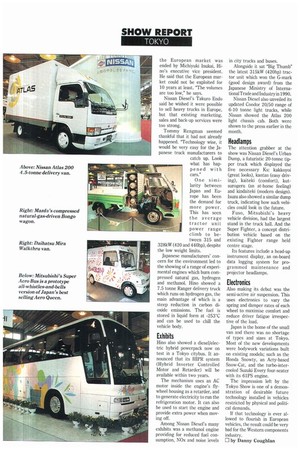SHOW REPORT
Page 47

If you've noticed an error in this article please click here to report it so we can fix it.
TOKYO
the European market was ended by Michiyuki lnukai, Hino's executive vice president. He said that the European market could not be exploited for 10 years at least. "The volumes are too low," he says.
Nissan Diesel's Takuro Endo said he wished it were possible to sell heavy trucks in Europe, but that existing marketing, sales and back-up services were too strong.
Tommy Rengman seemed thankful that it had not already happened, "Technology wise, it would be very easy for the Japanese truck manufacturers to catch up. Look what has happened with cars."
One similarity between Japan and Europe has been the demand for more power. This has seen the average tractor unit power range climb to between 315 and 328kW (420 and 440hp), despite the low weight limits.
Japanese manufacturers' concern for the environment led to the showing of a range of experimental engines which burn compressed natural gas, hydrogen and methanol. Hino showed a 7.5 tonne Ranger delivery truck which runs on hydrogen gas, the main advantage of which is a steep reduction in carbon dioxide emissions. The fuel is stored in liquid form at -253°C and can be used to chill the vehicle body.
Exhibits
Hino also showed a diesel/electric hybrid powerpack now on test in a Tokyo citybus. It announced that its HIPR system (Hybrid Inverter Controlled Motor and Retarder) will be available within two years.
The mechanism uses an AC motor inside the engine's flywheel housing as a retarder, and to generate electricity to run the refrigeration motor. It can also be used to start the engine and provide extra power when moving off.
Among Nissan Diesel's many exhibits was a methanol engine providing for reduced fuel consumption, NOx and noise levels in city trucks and buses.
Alongside it sat 'Big Thumb" the latest 315kW (420hp) tractor unit which won the G-mark (good design award) from the Japanese Ministry of International Trade and Industry in 1990.
Nissan Diesel also unveiled its updated Condor 20/50 range of 6-10 tonne light trucks, while Nissan showed the Atlas 200 light chassis cab. Both were shown to the press earlier in the month.
Headlamps
The attention grabber at the show was Nissan Diesel's Urban Dump, a futuristic 20-tonne tipper truck which displayed the five necessary Ks: kakkoyoi (great looks), kantan (easy driving), kaiteki (comfort), kutsurogeru (an at-home feeling) and kindaiteki (modern design). lsuzu also showed a similar dump truck, indicating how such vehicles could look in the future.
Fuso, Mitsubishi's heavy vehicle division, had the largest stand in the truck hall. And the Super Fighter, a concept distribution vehicle based on the existing Fighter range held centre stage.
Its features include a head-up instrument display, an on-board data logging system for programmed maintenance and projector headlamps.
Electronics
Also making its debut was the semi-active air suspension. This uses electronics to vary the spring and damper rates of each wheel to maximise comfort and reduce driver fatigue irrespective of the load.
Japan is the home of the small van and there was no shortage of types and sizes at Tokyo. Most of the new developments were bodywork variations built on existing models; such as the Honda Snowty, an Acty-based Snow-Cat, and the turbo-intercooled Suzuki Every four-seater with its 61PS engine.
The impression left by the Tokyo Show is one of a demonstration of desirable future technology installed in vehicles restricted by physical and political demands.
If that technology is ever allowed to flourish in European vehicles, the result could be very bad for the Western components industry.
El by Danny Coughlan




























































































































